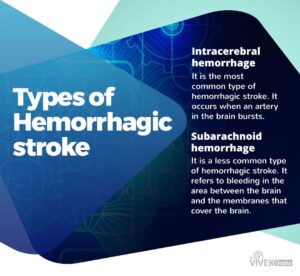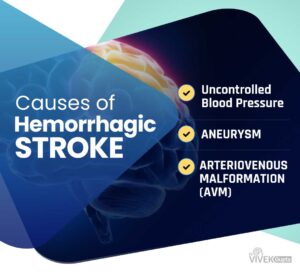

Strokes can be of two types. An ischemic stroke results due to a lack of blood flow to the brain cells and tissues. Blockage of brain blood vessels due to clot is major cause of this stroke. Clot can arise from the heart or from the brain blood vessels. An ischemic stroke is the most typical type of stroke and accounts for 87% of stroke cases.Another type of stroke is a hemorrhagic stroke resulting from a ruptured blood vessel in the brain. The blood from the ruptured vessels accumulates and puts pressure on the surrounding brain areas and it can be fatal. Infact, only two-third of the patients of hemorrhagic stroke survive. A hemorrhagic stroke accounts for the remaining 13% of stroke cases and has a higher death rate than ischemic stroke.
However, the good news is that immediate/early treatment improves the odds of recovery.
Hemorrhagic Stroke Symptoms
- Sudden severe headache (Typically called ‘worst headache of your life’)
- Nausea and vomiting
- Loss of consciousness
- Numbness or weakness if the leg, arm, or face on one side of the body
- Dizziness
- Seizures
- Confusion
- Loss of balance
- Difficulty in talking or swallowing
Hemorrhagic Stroke Causes


There are multiple causes of hemorrhagic stroke, but the most common ones are:
- Uncontrolled Blood Pressure
Prolonged and uncontrolled rise in BP may lead to bursting of tiny blood vessels of the brain causing a hemorrhagic stroke. - Aneurysm
It is a condition where a part of a blood vessel enlarges like a balloon due to a weak blood vessel wall. This bulging leads to the thinning of vessel walls and eventually cause them to rupture. It is the commonest cause of hemorrhagic strokes. - Arteriovenous Malformation(AVM)
It is a condition where blood vessels (arteries and veins) abnormally tangle without capillaries between them.The resultant blood vessels are weak and are prone to bleeding. This condition is usually present since birth.
Treatment for Hemorrhagic Stroke due to Brain Aneurysms
Medical Management
Once the bleeding is there in the brain, patients become very sick and require early hospital admission preferably in a dedicated neuro ICU. Here, medical management is given to decrease the symptoms of bleeding, manage increased blood pressure and in some cases ventilation if the patient has had severe bleeding. In addition to this, the cause of bleeding the aneurysm needs to be treated urgently because there is a very high chance of repeat bleeding.
Your physician may decide the best hemorrhagic stroke treatment based on the condition. Some common options include:
Endovascular Repair/coiling
In this form of treatment, the neurointerventional surgeon threads a catheter and thin wire through blood vessels into the aneurysm. A coil of platinum wire, which is as thick as a strand of your hair, is released into the area. The coil acts as a net, preventing blood from flowing into the aneurysm. Multiple coils are introduced inside the aneurysm till the time no blood flow is seen inside the aneurysm.
The procedure prevents rebleeding. In this type of treatment, there is no scar over the head and the entire treatment is done through a tiny hole in the groin or wrist. In general, this form of treatment is less risky then open surgery and recovery time is less.
Open Surgery/Clipping
In this form of treatment, the skull is opened up and the brain is separated to reach the site of the aneurysm. Once there the blood flow into the aneurysm is blocked with an aneurysmal clip that prevents it from bursting or bleeding further. Depending on the aneurysm’s size and location, surgery may or may not be a good option.
Coiling Versus Clipping
Both are established treatments for aneurysm treatment. The decision of which modality is better in a given case is based on, location of the aneurysm, size and configuration of the aneurysm, age, existing medical conditions and available local expertise. However, in general, coiling is safer when compared to open surgery in the majority of cases.
Hemorrhagic Stroke Recovery Time
Generally, after a ruptured/burst aneurysm is repaired patient would need 10-14 days additional stay in the hospital so that complications arising from blood collected in the brain can be managed. The duration of rehabilitation and recovery depends on the amount of bleeding, tissue damage and the severity of the stroke. You may need different therapies, depending on your needs. Some examples include occupational therapy, physical therapy, and speech therapy.
